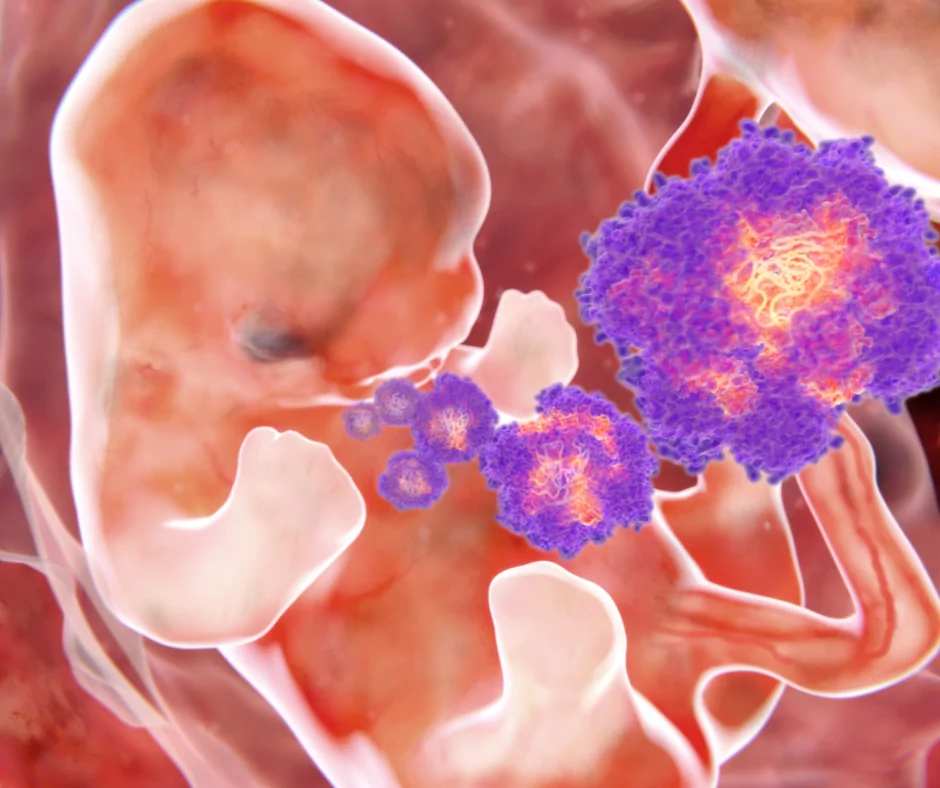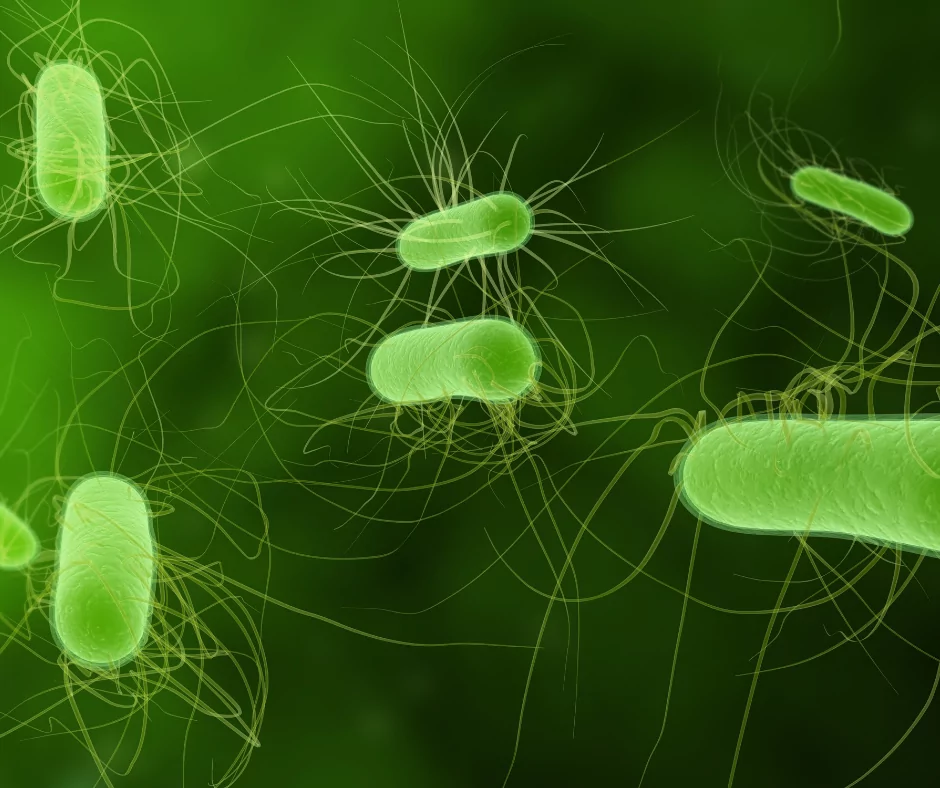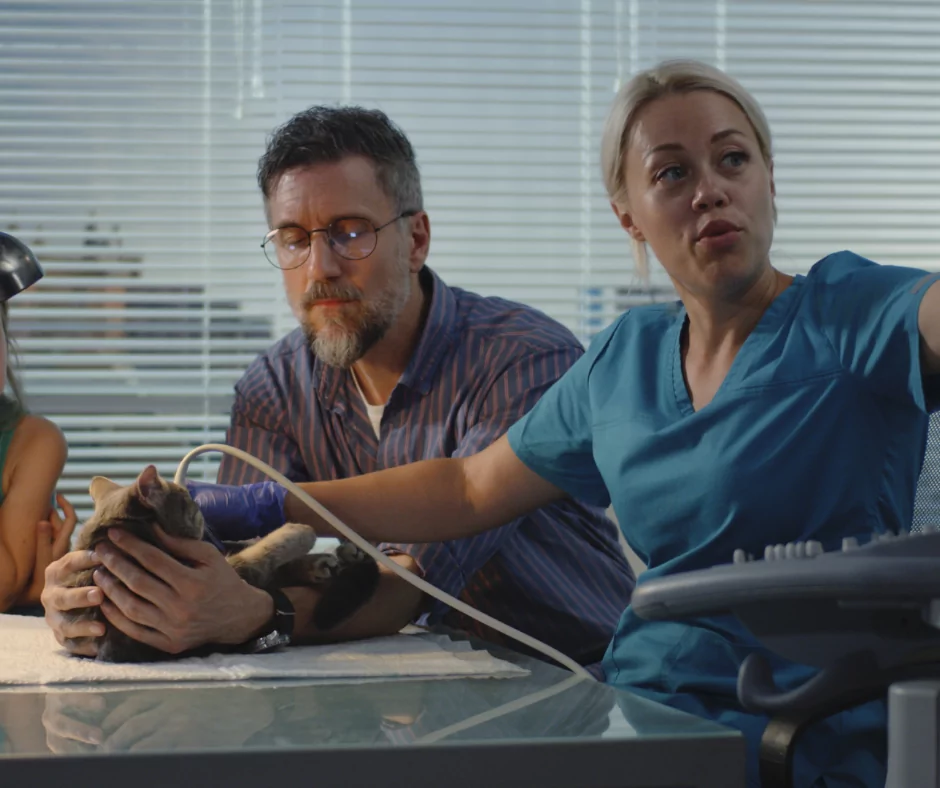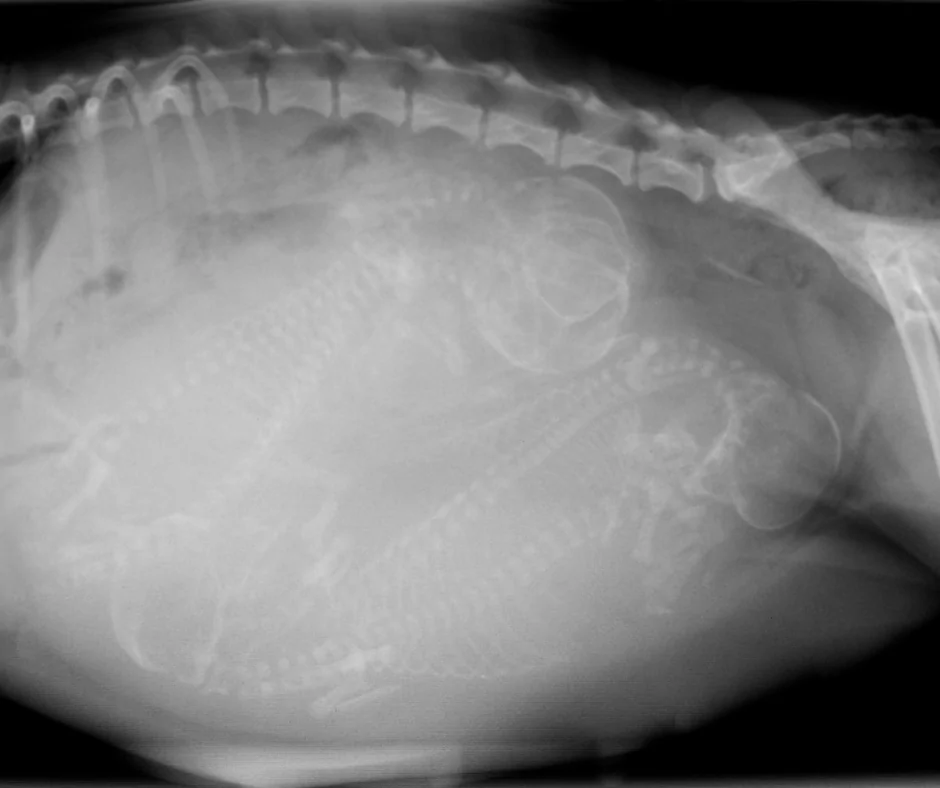How is Fetal Resorption in Animals Different from Humans?
Fetal resorption, or also known as resorption of the fetus, is a process during which the maternal body disintegrates and assimilates one or more fetuses inside the uterus.
In animals, for example, small companion animals, this process will happen in the first half of the pregnancy, or when all tissues are still soft, and the bones are not properly formed yet.

In comparison, fetal resorption in humans will happen at any stage after the organogenesis is complete or after the ninth gestational week. If there is embryonic death before the ninth gestational week, it is not called fetal resorption but embryonic loss. In humans, embryonic death later in pregnancy is called a miscarriage.
Animal Fetal Resorption – The Medical Definition in Animal Terms
The common medical terms used to describe fetal resorption in small animal medicine are canine fetal resorption and feline fetal resorption. This represents a biochemical process in which we can observe a live fetal organism’s decomposition and deterioration. This process includes the disintegration of enzymes in the fetus while it is still in the womb. This will result in the total obliteration of the organism and resorption of the fetal tissue.
Any death to the embryos in the first week or two of gestation is not considered fetal resorption. Instead, it is listed as an embryo loss.
After a certain period in gestation, roughly after 44 days, there cannot be fetal resorption. This is due to the development of skeletal bones, and these cannot be absorbed. Because of this, fetal resorption in dogs and cats can occur only before the development of skeletal bones or when the fetuses are made only of soft tissue.
Most fetal resorptions in small animals happen to one or two puppies or kittens in the litter. There are rare occasions when the entire litter is absorbed.
After the early death of the fetus or fetuses, they will not exit the mother’s body. The bitch’s and queen’s body first begins to absorb the placenta and all surrounding tissues and then the entire fetus itself.

This means that the reabsorbed fetus will disappear from the litter and the uterus in a natural chemical process.
This systematic resorption works in advantage to the mother’s body because it is very dangerous to abort a fetus while the rest of the litter is still alive and carried to term. This chemical process of fetal resorption helps the mother eliminate the risks of anything happening to the rest of the litter during the pregnancy and delivery.
Another medical term used to describe the chemical process of fetal resorption is “Vanishing Twin.” This explains that the reabsorbed fetus’s remains can be taken by the other puppies, kittens, or mothers. This can be very confusing for the pet owners but is quite common in canine reproduction, 11% common.
Reproductive Toxicity
Many factors can cause fetal resorption in small animals, but all these factors can be divided into two groups: infectious and non-infectious factors.
In dogs, the most common reasons for fetal resorption can be determined by performing an autopsy of the fetus and the placenta or taking a vaginal swab and testing blood serum changes in the mother.
Vaginal swabs alone are not the best way to diagnose the reason for the fetus’s loss because the reproductive tract of dogs already contains amounts of bacteria that are considered normal vaginal flora and will give positive swab results. But, any bacterial species that will overgrow can cause an infection and a subsequent fetal resorption.
In cases like these, a definitive diagnosis should be made via cultures from an aborted fetus and cytology from smears taken from the uterus and the vagina.
Use of antibiotics during pregnancy should be avoided because it can lead to an overgrowth of Mycoplasma and E. coli, leading to malformation or loss of a fetus or fetuses.

The Maintenance of Animal Pregnancy
The only hormone essential and required to maintain a normal and healthy pregnancy in dogs and cats is progesterone. However, normal estrogen concentrations may be necessary for lactation and full mammary development.
The only source for progesterone in dogs and cats is ovarian, or more specific the corpus luteum. Ovarian progesterone secretion increases from day 30 of the pregnancy till near term.
The luteal progesterone production will require both prolactin and LH (luteinizing hormone) to maintain a normal pregnancy. The suppression of these hormones will result in the termination of the pregnancy.
For maintaining a healthy pregnancy, the dog or cat needs to be perfectly healthy before breeding. The pregnancy can exacerbate health conditions such as heart disease, kidney disease, diabetes mellitus, or toxemias. They can be dangerous and even fatal for the pregnant dog or cat.
Nutrition during pregnancy is very important to maintain a healthy pregnancy and deliver healthy puppies and kittens. In the first six weeks of the pregnancy, less than 30% of the fetal growth occurs, so in this period, the pregnant dog or cat should eat a regular diet as before the breeding.
In the last three to four weeks of the pregnancy, fetal growth increases rapidly, and a gradual increase of up to 25% of the food intake is recommended. Some dogs and cats are switched to a high-quality puppy or kitten food because they have higher amounts of proteins, minerals, vitamins, and carbohydrates.
Calcium supplements should not be given before delivery unless advised otherwise by a veterinarian. Studies have shown that calcium supplementation before delivery can be associated with eclampsia, dystocia, and litter problems.
What is Spontaneous Embryo Resorption?
Spontaneous embryo resorption is a term that describes the loss of implantation from unknown maternal or embryonic causes. In mammals, in normal fetal development, a certain number of blastocysts are lost after or before implantation by spontaneous resorption.
Assessment of the prevalence of spontaneous resorption in the early stages of pregnancy in small animals is challenging. Based on the different number of eggs, embryos, and actual puppies and kittens born, it is estimated that the total embryonic loss is over 20%.
How Can Fetal Resorption be Detected?
Fetal resorption, as the word resorption describes, cannot be detected. The only possible way to know that fetal resorption occurred is if we know the exact number of puppies and kittens (radiography or ultrasonography) and match that number with the ones that will be born.

In fetal resorption, the entire chemical mechanism favors the mother and reabsorbs the fetus as the whole along with the placenta.
If fetal resorption is suspected, laboratory tests are advised to determine the reason for it. If the etiology is infectious, then appropriate therapy should be prescribed.
What Causes Embryo Resorption?
Infectious factors for fetal resorption in dogs
Salmonella infection
Salmonella is a Gram-negative, rod-shaped bacteria that are not commonly found among the normal vaginal flora. Dogs get infected with Salmonella by eating contaminated food or feces and drinking contaminated water.
Salmonella infection can be diagnosed with a culture from a vaginal discharge or aborted material. If the infection is confirmed, the patient should be given appropriate antibiotics and isolated from other household dogs.
Campylobacter infection
Campylobacter is a Gram-negative bacteria that, if contracted, can lead to fetal resorption and abortion in dogs. A definitive diagnosis can be made with a culture from a vaginal discharge or aborted material. The infection is treated with appropriate antibiotics.
Canine parvovirus I infection
The canine parvovirus is a very contagious disease that puts young dogs and puppies at very high risk. When a pregnant dog contracts the virus, she will show no signs or symptoms of the disease but is deadly to the entire litter. Diagnosis is challenging, and there is no treatment.
Canine herpesvirus infection
There is no viable information about what happens if a pregnant dog contracts the canine herpes virus in the first half of the pregnancy. But, in the last three weeks of the pregnancy, a herpesvirus infection will result in abortion and the fetuses’ mummification.
A definitive diagnosis can be achieved by isolating the virus from the placenta or an aborted fetus. There is no treatment, but pregnant dogs should be separated from other dogs in the household in the last three weeks of the pregnancy to prevent a possible infection.
Mycoplasma infection
Mycoplasma is a type of bacteria that lacks a cell wall and is resistant to most antibiotics. This bacteria is most likely to cause an infection in overcrowded kennels. Appropriate antibiotics can lower the number of organisms present, but the bacteria number will rise again once the antibiotics stop.
Toxoplasmosis infection
This is an infrequent cause for fetal resorption and abortion in dogs. The dogs acquire the infection by eating cat feces or raw meat. A definitive diagnosis is made with a specific blood test.
Non-infectious factors for fetal resorption in dogs
Maternal health
Many non-infectious health factors play a considerable role in maintaining a healthy pregnancy in dogs. Several illnesses and factors can contribute to fetal resorption and the loss of a litter.
These factors include diseases such as hormonal diseases (Cushing syndrome, hypothyroidism, Diabetes mellitus, and Addison’s disease), changes in the uterus (cystic endometrial hypoplasia), dietary deficiencies, abdominal trauma, exposure to chemicals.
Genetic causes
Fetal mortality rate and fetal resorption are much higher in purebred dogs than in mixed breed dogs. Inbred dogs tend to have fewer live births and a lower conception rate than outbred dogs.
Drugs
Days 6 to 20 of the pregnancy in dogs are critical for embryotoxicity, and it is advised to avoid the use of drugs during this period. Dog owners and veterinarians should altogether avoid the use of corticosteroids, cytostatics, and organophosphates in pregnant dogs.

Hypoluteodism
This condition is manifested by an insufficient progesterone level than the one required to maintain a healthy pregnancy. The normal progesterone levels in female dogs are expected to be higher than 2ng/ml, and values even higher than 20ng/ml are widespread.
Any reputable breeder would be advised to monitor the progesterone levels at least once a week. If the progesterone level drops to 5ng/ml when there is one gestational week left, it is advised to give progesterone supplements.
Progesterone supplementation should be avoided during the first three weeks of the pregnancy in dogs due to the risk of masculinization of female fetuses. If progesterone supplementation is given, it should be stopped three days before the puppies’ expected delivery to avoid suppressing milk production and the risk of the fetuses being retained too long.
Factors that cause fetal resorption and abortion in cats
The most common cause of fetal resorption and loss of litter in cats is infection. These infections can be viral, bacterial, or parasitic. The most common type of infection seen in cats with fetal resorption is viral, more specifically FIV, FeLV, FPV, feline herpesvirus, and feline coronavirus.
When a cat loses her entire litter, bacterial cultures are carried. Still, even if bacterias are diagnosed, it is difficult to determine whether they cause fetal resorption or abortion.
Other common causes for fetal resorption in cats are hormone changes, more specific low levels of progesterone.
Animals That Are Prone to Fetal Resorption
Animals prone to fetal resorption are dogs and cats that live in crowded kennels, mothers from puppy mills, malnourished dogs and cats, animals subjected to inbreeding, and animals living with undiagnosed diseases before breeding.
To have a happy and healthy pregnancy, no matter if it is a dog or a cat, it is of utmost importance to have a healthy mother. Genetic screening and laboratory testing to exclude bacterial and viral diseases are recommended. It is very important to avoid inbreeding as these dogs have a lower conception rate and higher fetal resorption rate.
No specific dog breeds are more prone to fetal resorption than others, but studies have shown that purebred dogs have a higher prevalence of embryonic resorption than mixed breed dogs.
Conclusions
Fetal resorption is a condition that defines the dissolving of a fetus and all its tissues, including the placenta. This can happen in about 11% of all pregnancies in the first three weeks of gestation in small animals. Many factors contribute to this, some of which include viral, bacterial, and protozoan infection.
For the maintenance of a healthy pregnancy in dogs and cats, it is essential to maintain a healthy, risk-free environment and a healthy mother. Periodic checking of pregnancy hormone levels is advised for a full-term pregnancy and standard delivery.
If you enjoyed this article, why not read our article on 12 animal gestational periods.
